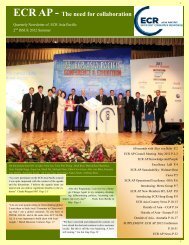You also want an ePaper? Increase the reach of your titles
YUMPU automatically turns print PDFs into web optimized ePapers that Google loves.
In the short-term, tertiary unit load design will involve<br />
a number of trade-offs, such as:<br />
7.4. Trade-offs<br />
• Maintaining a space efficient load, requiring<br />
minimum handling throughout the supply chain<br />
versus investment to remove capacity constraints<br />
• Space utilisation versus handling costs around a<br />
constraint, e.g. around a height constraint at the<br />
entry to the distribution centre – until this point<br />
transport can maximise use of the cube at the<br />
constraint, handling costs are incurred to lower<br />
heights accordingly<br />
• The efficient use of retail display space, with small,<br />
frequent deliveries, versus the penalty associated<br />
with poor vehicle fill<br />
• Investment in new EUL and transport infrastructure<br />
versus investment in new scheduling systems to<br />
maximise the time dimension of capacity utilisation.<br />
Both should take place<br />
• Maximum tertiary load height or fill versus<br />
secondary count<br />
• Cost of own tertiary fleets, especially non-captive<br />
versus use of a tertiary pool<br />
• Tertiary strength and design versus strength of<br />
primary and secondary contents<br />
• Load heights versus cost of providing suitable<br />
equipment to ensure safe, ergonomic picking<br />
• Tertiary item cost versus security and protection of<br />
contents<br />
• Penalties of dealing with a mixture of tertiary item<br />
types versus the investment required to standardise<br />
on one type, e.g. pallets<br />
• Creating one tertiary load for all supply chains and<br />
players, with low complexity, but some penalties,<br />
versus a variety of tertiary loads to optimise<br />
different supply chains and/or parts of supply<br />
chains, with cost of complexity, but lower penalties.<br />
52<br />
7.5. Other Guidelines<br />
Load stability<br />
Load stability is essential to prevent disintegration<br />
during handling, storage and shipment. This minimises<br />
product damage and avoids possible danger to<br />
personnel. Minimum material should be used for<br />
stabilisation and it should be as “ecological” as<br />
possible. The stabilisation material should also be easy<br />
to remove without damaging the product. Both<br />
columnar and interlocked stacking of secondary items<br />
are acceptable, although the Euro pallet only<br />
accommodates columnar stacking, whereas the<br />
Industry pallet allows interlocked stacking of 600x400<br />
secondary items.<br />
Effective administration systems and reverse<br />
logistics<br />
It is essential to develop an effective administration<br />
system for tertiary items, similar to that described for<br />
RTI in Chapter 6. An efficient and effective return<br />
logistics system is also mandatory. Existing pallet pools,<br />
and recommendations on RTI return logistics in<br />
Chapter 6, both provide examples of best practice.<br />
Exchange pallet systems can create problems,<br />
especially in automatic pallet handling systems, if the<br />
pallet exchanged is of a lower quality than the pallet<br />
issued. No pan-European standards exist covering<br />
pallets in use, but key criteria are damage levels,<br />
cleanliness, possible contamination from previous loads<br />
and moisture content (which affects pallet load<br />
protection and pallet item weight).<br />
The Efficient Unit Loads Report










